 |
 |
FABULOUS
100TH
ISSUES
HOW
COMIC BOOK COVERS
CELEBRATE CENTENARIES
THE
GOLDEN AGE (1938-1956)
|
|
|
|
| |
|
| |
| Comic books come in many
different forms and sizes, but there's one thing (almost)
all of them have in common: they're numbered, and the
numbering is continuous (unlike most periodicals and
magazines, which often had their numbering broken down
into annual volumes. |
| |
| The
reason for the continuous numbering is linked by
several sources (e.g. Miller, 2011) to the comic
book's ancestral roots in the Penny Dreadfuls,
Dime Novels and Pulps of the late 18th and early 19th century, all of which also
used a continuous numbering system. One might
assume that it must have felt like a logical
choice for publishers of the new comic book
format in the 1930s. But whereas the system used
was generally the same, the way the number of a
comic book issue was displayed varied greatly
from publisher to publisher.
In some cases it
featured prominently on the cover (a system which
evolved into specific placeholders and would
eventually also include month, price and even
additional information), in others the issue
number was hidden in the indicia at the bottom of
the first page or even coded (as was the case
with Dell's titles).
It seems however
safe to assume that, at least initially, the
ongoing numbering of issues of a given comic book
title served the organisational needs of editors,
publishers and distributors more than it ever
really served a purpose for readers.
|
|
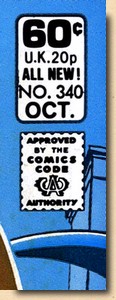 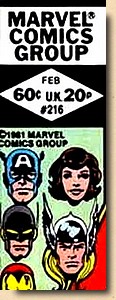
|
|
| |
| This was certainly true for
as long as individual issues of comic books were
self-contained, meaning they could really be read in no
specific order at all. Things only changed when
continuity was introduced and a growing base of regular
readers-turned-fans evolved. This would be especially
true for Marvel Comics, of course, where readers not only
knew what happened several issues ago but were quite
often reminded of that fact by way of an editorial
footnote. Numbers also
have a psychological effect, of course. In the case of
comic books, popular wisdom has it that newsagents and
other points of sale preferred titles with higher issue
numbers, indicating an established brand. And many comic
book titles certainly were racking up the issue count by
the mid-1950s, although not always for reasons of brand
stability. In fact, sometimes it was for outright
opposite reasons.
"Paul
Levitz once suggested to me that one reason so
many titles simply changed names rather than started
anew at #1 was logistical. It was easier for a
publisher to change the title on a series than get a
new one set up [with his] printer’s and [...]
distributor’s systems." (Miller, 2011)
|
| |
|
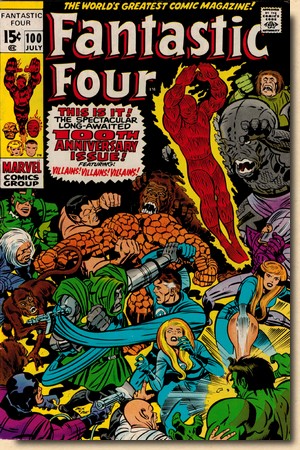
Fantastic
Four #100 (July 1970)
|
|
As a result,
comic books changed their title
several times while simply
keeping the original numbering -
but this was by no means
restricted to the 1940s and
1950s, as the example of Marvel's
Fantasy
Masterpieces illustrates:
issue #11 (October 1967) was
followed two months later not by Fantasy
Masterpieces #12 but rather Marvel
Super-Heroes #12 (December
1967) - new title, continued
sequential numbering.
These days,
things are different, as a
seemingly never-ending succession
of reboots and subsequent first
issues from publishers across the
board shows that nothing sells
quite like a #1 issue. But what
about centenary issues? That
moment when a title reaches three
digits in its numbering for the
first time?
Fantastic
Four #100, cover dated July
1970, was the first of Marvel's
superhero titles to reach the one
hundred issues mark in actual
numbering, i.e. without any
changes to title or character
content, and its Jack Kirby cover
is what Marvel fans would come to
expect for such an occasion:
crammed with good guys and bad
guys and a blurb that proclaims "THIS
IS IT! THE SPECTACULAR
LONG-AWAITED 100th ANNIVERSARY
ISSUE!".
However, the
anniversary fireworks were
limited to the cover - rather
surprisingly (given Marvel's
pronounced tendency towards
self-celebration), both Stan
Lee's Soapbox and the Bullpen
Bulletin lost not a word on the
occasion.
Did comic
books quite simply not celebrate
centenaries other than on their
covers? A look back in time,
starting here with the so-called
Golden Age (1938-1956), provides
some contradicting answers to
this question.
|
|
|
|
| |
 |
| |
|
| |
| Famous Funnies,
published monthly since July 1934 and considered by many
scholars and fans alike to be the first true American
comic book title, was the first to reach the centenary
benchmark, and publisher Eastern Color/Famous Funnies
Inc. certainly celebrated that fact in style in October
1941, with a cover that made absolutely certain readers
couldn't miss the milestone occasion of the title's "100th
Anniversary". |
| |
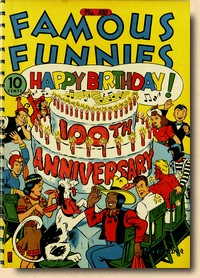 Famous
Funnies #100 Famous
Funnies #100
(Eastern Color, October 1941)
|
|
The cover was made to almost
look like an invitation to a birthday party (one
where all the various characters featured in Famous
Funnies were present at), and editorial
acknowledged the anniversary on the letters page,
proudly pointing out that this was the "first
comic to be published for 100 consecutive
months".
Thanking
readers for their loyalty, editorial also noted
that "we are looking forward to enjoying
with you the time when FAMOUS FUNNIES will have
been published continuously for 200 months instad
of 100 months".
That
wish would be granted - the title would continue
in publication for a total of 218 issues before
cancellation hit in July 1955.
So did Famous
Funnies set the tone for future centennial
comic books and their covers?
|
|
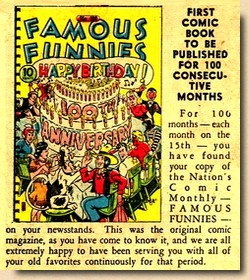
Famous Funnies #100
|
|
| |
Well, not
really.
Dell was the
next publisher with one hundred issues of a title on its
hand,in June 1944, but when Popular Comics
(first published in February 1936) achieved that feat,
there wasn't even the mildest hint of any celebrations,
with the issue number #100 on the cover being all there
was to it.
And the same
maxed out understatement could be seen with the three
other titles reaching 100 issues in 1944: King
Comics, Tip Top Comics, and More Fun Comics
(which was the first DC title to reach that benchmark,
featuring Aquaman and Green Arrow, both introduced in
issue #73).
|
| |
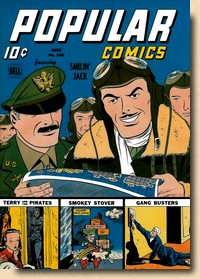 Popular
Comics #100 Popular
Comics #100
(Dell, June 1944)
|
|
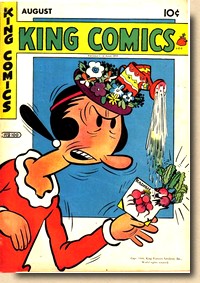
King Comics #100
(David McKay, August 1944)
|
|
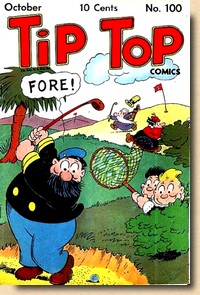
Tip Top Comics #100
(United Feature, October 1944)
|
|
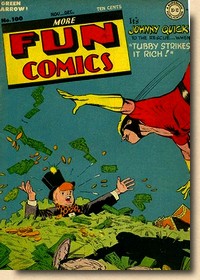
More Fun Comics #100
(DC, November 1944)
|
|
| |
| The next big title to
celebrate its centenary was Detective Comics
in June 1945 - except Detective Comics
#100 didn't really celebrate anything, with not a
single word mentioning the occasion anywhere -
not even on the cover, which on top of it all
featured the Batman squeezed into the bottom left
corner and wearing a rather peculiarly pinkish
outfit. Clearly,
Famous Funnies #100 had been an
exception, and the general rule in the comic book
industry of the 1940s was to simply ignore
centenaries.
The major reason for
this lacklustre handling of anniversary issues
may well be rooted in the fact that before the
rise of fandom and a newly gained
self-confidence, comic book publishers and
artists as well as distributors saw comic books
as one of the ultimate cheap and disposable
entertainment forms. Readers came and went, and
the stories in each issue were unconnected other
than through the main characters (e.g. Batman and
Robin), so why even bother?
As the 1940s
progressed, more and more comic book titles
reached number 100 in their issue count, but none
of them made the least effort to mark this as a
"special issue". In terms of sales, it
simply wouldn't have made a difference at the
time. Accordingly, neither DC's Adventure
Comics #100 (October 1945) nor Action
Comics #100 (September 1946) make any
mention of the centenary, be it on their covers
or their interior pages.
|
|
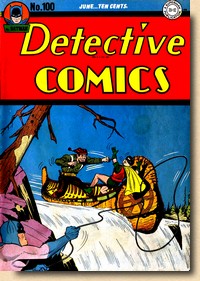
Detective Comics #100
(DC, June 1945)
|
|
| |
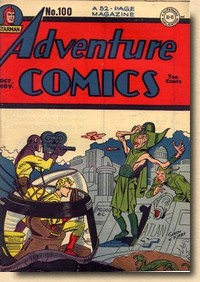 Adventure
Comics #100 Adventure
Comics #100
(DC, October 1945)
|
|
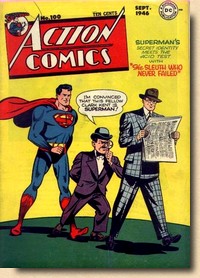
Action Comics #100
(DC, September 1946)
|
|
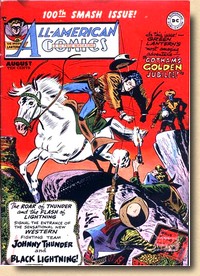
All-American Comics #100
(DC, August 1948)
|
|
However, DC did break the
established centenary silence in August 1948, by
proclaiming All-American Comics #100
(starring Johnny Thunder as well as the Golden
Age Green Lantern, Dr Mid-Nite, and Atom) to be a
"100th SMASH ISSUE!" - only
the second cover to do so after Eastern Color's Famous
Funnies #100 in October 1941.
As a
sidenote, DC had purchased this title from
All-American Comics only two years prior - and it
would become All-American Western as of
issue #103.
|
|
| |
| At this point in time,
centenary issues started to hit the newsstands at a
regular pace, and the next in line after All-American
Comics #100 was Whiz Comics #100, also in
August 1948. But whereas DC had been content with a top
of the cover banner, Fawcett retraced the footsteps of Famous
Funnies #100 when Whiz Comics #100 also
featured a birthday cake on its cover. |
| |
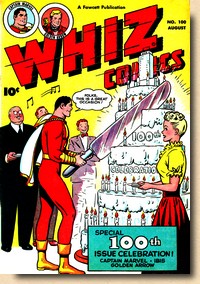 Whiz
Comics #100 Whiz
Comics #100
(Fawcett, August 1948)
|
|
But that wasn't it - taking
matters even a few steps further than Famous
Funnies #100 back in 1941, Whiz Comics #100
was full of references to the centenary.
An
editorial shout out on the back of the inside
cover was followed by a Captain Marvel story
which kicked off with the publishers of Whiz
Comics hosting an anniversary gala, which
served as an opening to a story full of constant
references to the number 100.
99
guests at the gala dinner are joined by Captain
Marvel's archenemy Sivana, who is described as "100
villains rolled into one".
|
|
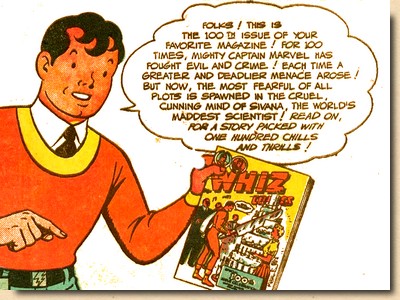
Whiz Comics #100
|
|
| |
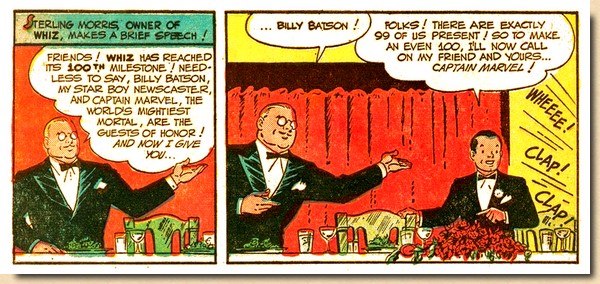
|
|
Writer Otto
Binder really piled it on with
his story, and as a result,
"The Hundred Horrors"
is not only clearly a 100th
anniversary story, but also the
very first.
While other
publishers were flat out ignoring
their titles' centenaries,
Fawcett had a really good go at
it.
Two months
later, for the October 1948
publication run, it was once
again DC who had their next title
clocking up 100 issues, this time
with Flash Comics #100.
|
|
|
|
| |
| But just as with All-American
Comics #100 two months prior, the only indication of
a centenary anniversary was restricted to a banner at the
top of the cover, albeit this "100th SMASH
ISSUE!" was now also "SPECIAL". |
| |
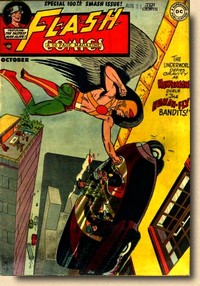
Flash Comics #100
(DC, October 1948)
|
|
But that was it. No editorial
celebrations, and the stories featured in Flash
Comics #100 were classic standalone plots
that could have been printed in any issue of that
title.
The
next two titles to reach their cenetenaries -
Wings Comics #100 from Fiction House in
December 1948 and Master Comics #100
from Fawcett in February 1949 - kept total radio
silence about their anniversary, and it wasn't
until April 1949 and Columbia's Big Shot #100
that comic book readers got to see another
birthday cake cover on the newsstands.
Strett
& Smith, the next publisher with a centenary
issue on their hands, kept total silence about
this fact in Shadow Comics #100 (July
1949), but the last 100th anniversary title of
the 1940s did just the opposite - maybe not
surprising since it was once again published by
Fawcett and once again featured Captain Marvel.
|
|
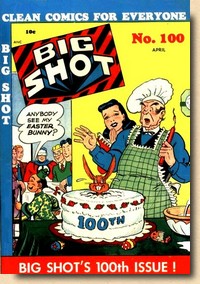 Big
Shot #100 Big
Shot #100
(Columbia, April 1949)
|
|
| |
Once again scripted by Otto
Binder, Captain Marvel's "anniversary
story" (a four part tale spread out over 33
pages) didn't quite go as far as his previous
centenary adventure in Whiz Comics #100
a year prior to Captain Marvel Adventures #100
(September 1949). This time, the references were
kept to the first and final panels, used as a
"framing device" rather than a plot
element.

|
|
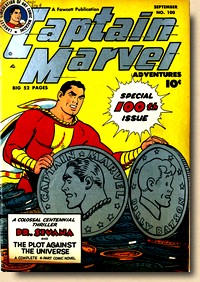 Captain
Marvel Adventures #100 Captain
Marvel Adventures #100
(Fawcett, September 1949)
|
|
| |
| At the time, Fawcett's
titles featuring Captain Marvel sold well over a million
copies each every month, so it made perfect marketing
sense to let readers know about landmark issue
achievements and to "bond" with them (an
approach elevated to an artform later on, in the 1960s,
by Stan Lee). For other titles, the reality at the
newsstand was such that they sold well enough, but
nowhere enough to trump up anything. This was also the case for the first
centenary issue of the 1950s, DC's Star Spangled
Comics #100 (January 1950). Even though Robin
"the Boy Wonder" had a solo feature in this
title since February 1947, there was no centenary
indication to be found. The same held true for Looney
Tunes and Merrie Melodies Comics #100 (Dell,
February 1950), Police Comics #100 (Quality
Comics, June 1950) and Modern Comics #100
(Quality Comics, August 1950).
A somewhat unusual approach
to having a #100 issue was taken by UK publisher L.
Miller & Son in April 1950 when they launched their
British market Fawcett reprint title Captain Midnight
by starting the issue count at 100 rather than 1 -
definitely a somewhat rushed centenary (which however,
and perhaps understandably so, did without any cover
fanfare). It was not, however, to be the only time a
publisher opted for this kind of advanced numbering
scheme - US publisher Toby launched their short-lived Buck
Rogers comic in Janaury 1951 with issue #100.
|
| |
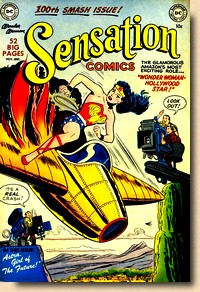
Sensation Comics #100
(DC, November 1950)
|
|
DC's Sensation Comics
#100 (November/December 1950), featuring Wonder
Woman and three additional features with female
heroines, marked a return to the cover blurb "100th
SMASH ISSUE!", but as before, editors
at DC did not think the occasion worthy of
anything more.
By the
very early 1950s, a number of centennial issues
were hitting the newsstands which were examples
of the continued numbering of a comic book which
had undergone one or more title changes in the
process.
Such
was the case with Marvel Tales #100
(April 1951), which only existed as a title since
issue #93 as it continued the numbering of Marvel
Mystery Comics (#2-91), which in turn had
started out as Marvel Comics #1 in October 1939.
Whilst
therefore not in an uninterrupted original title
numbering sequence, Marvel Tales #100
was nonetheless the first Marvel title to reach a
centenary.
|
|
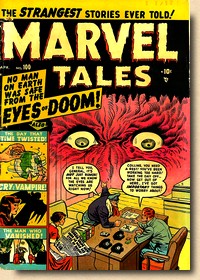 Marvel
Tales #100 Marvel
Tales #100
(Marvel, April 1951)
|
|
| |
| A certain Stan Lee was
already at the editor's helm, but he had yet to develop
his special style in relating to readers - and as a
result, not a word other than the numbering on the cover
was lost on this occasion. A similarly "mixed title"
centenary occured in June 1951 when Fawcett's Sweethearts
#100 hit the newsstands. A monthly romance title, it had
started out as Captain Midnight (#1-67), and
inspite of the change from superhero to romance title,
Fawcett kept the numbering going - providing a striking
illustration to Paul Levitz's previously mentioned
assessment that "it was easier for a publisher
to change the title on a series than get a new one set
up" with his distributor (Miller, 2011).
Another example was Lev Gleason's Crime Does Not Pay
#100 (July 1951), which had been called Silver Streak
for its first 21 issues.
Another true (i.e.
continuous numbering on the same title) centenary took
place with Sparkler Comics #100 in July 1951,
but as so many publishers before, United Feature didn't
deem the occasion worthy of any mentioning on the cover,
let alone on any editorial interior page.
|
| |
| August 1951 saw yet another
of Fawcett's range of Captain Marvel titles reach
its centenial, but while the cover of Captain Marvel
Jr #100 was literally banging its drum about
the event, no further mentioning of it was made
in the interior pages, and the "sensational
3-parter" story featuring the teenage
equivalents of Captain Marvel and his arch-enemy
Sivana carried no puns or references either. Maybe the change of
writer had
something to do with it (Otto Binder had been in
charge of both the Captain Marvel centenary
stories, in Whiz
Comics #100 and Captain Marvel
Adventures #100 in 1948 and 1949
respectively, but Bill Woolfolk was in charge of Captain Marvel
Jr #100). but it is more likely that
editorial just didn't feel like it.
Fawcett had
just won the copyright infringement lawsuit that
National (DC) had initiated (alleging that
Captain Marvel was based on Superman), but at the
same time the popularity of superheroes was in a
stark decline. The drop in the sales figures of
their titles, which by 1949 only amounted to half
of what they had been during the war years
(Wright, 2001), had publishers scrambling to find
new genres which would bring readers back to the
newsstands. On top of this, DC's appeal regarding
the copyright infringement decision was
successful, all of which would lead Fawcett to shut down its entire
comics division in the autumn of 1953.
|
|
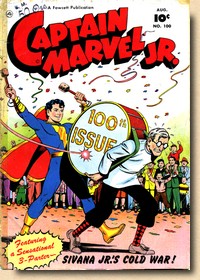 Captain
Marvel Jr #100 Captain
Marvel Jr #100
(Fawcett, August 1951)
|
|
| |

Fredric Wertham
(1895 - 1981)
|
|
But the comic book industry
was facing more than just hard times - it was
staring at nothing less than the possibility of
its eradication.
Fredric Wertham, a psychiatrist
from New York, had initiated his crusade against
comic books - which in his eyes were the prime
source of juvenile delinquency - in 1948, and by
1951 he was whipping public opinion into a
frenzy. His calculated (and ultimately also
deceitful) shaming and blaming would lead to the
infamous 1954 senate hearings and the subsequent
creation of the Comics Code Authority. The
afterglow of Wertham's crusade, however, could be
felt for years.
"In the post-war era
of McCarthyism, comics were an attractive
target for grand-standing politicians eager
for villains. Publishers were raided by the
police, titles were outlawed in dozens of
states, and some communities held public
comic-book burnings. (...) Comic sales
plummeted, hundreds of artists and writers
lost their jobs." (Staley, 2018)
|
|
| |
| By the early 1950s, comic
book publishers had
very little to celebrate, and centenary issues certainly
weren't one of those things, especially given the
outright disinterest most publishers had displayed
towards them previously. Hence, the next few centenary
issues published continued the tradition of having no
mention of the occasion whatsoever. The titles in
question were also further prime examples of how the
comic book industry was trying to adapt to the changing
times by changing titles and, more and more often,
content. Red
Ryder Comics #100, published by Dell in November
1951, had originally been published by Hawley for six
issues before being taken over by Dell, who would change
the title to Red Ryder Magazine as of issue
#145; with issue #149 it became Red Ryder Ranch Comic
before merging into Four Color #916.
|
| |
| October 1952 saw the
centenary issue of Gilbert's Classics
Illustrated (with a rendering of Mutiny on
the Bounty but no hint at the special issue
number), followed by Dell's Tom & Jerry
Comics #100 in November 1952; the latter
title had started out as Our Gang Comics
(#1-39) and then Our Gang with Tom &
Jerry (#40-59). In April 1953
St. John published Paul
Terry’s Comics #100, followed in July
by Lev Gleason's Daredevil Comics #100.
Neither of the two made any reference to the
number count benchmark, but the cover of Daredevil
did feature a sign of the times: the Association
of Comics Magazines Publishers (ACMP)
"comics code" star emblem.
Formed
in 1948 by founding members Lev Gleason, Bill
Gaines (EC Comics), Harolod Moore (Famous
Funnies), and Rae Herman (Orbit
Publications), the ACMP's "Publishers
Code", drawing heavily on the Hollywood
"Production Code" (better known as the
"Hays Code") which had been drafted in
similar circumstances, i.e. to stave off external
regulation.
Daredevil
Comics in itself was also a telltale
showcase of the changing times within the comic
book industry - once a superhero comic book
(where the hero, Daredevil, had battled Hitler in
its premier issue back in 1941), it had dropped
one of the Golden Age's most acclaimed masked
hero for comedy in 1950, simply adding the
"Little Wise Guys" to the original
title.
That same month,
Prize's bi-monthly (July-August 1953) Prize
Comics Western #100 featured a special
centenary cover pencilled and inked by John
Severin - though that was the only tip of the hat
to the occasion to be found in the entire comic
book.
August 1953 saw yet
another centenary issue with K.K. Publishing's Boys'
and Girls' March of Comics #100. The
somewhat cumbersome title started out in 1946 as Boys'
and Girls' Comics and covered a whole range
of different genres; while issue #100 featured a
Roy Rogers cover and different advertising
banners (taking up one third of the cover and
differing by region), no special mention of the
centenary occasion was made.
Archie Comics was
next in the line of centenary issues with Pep
Comics #100 in November 1953 - and like most
titles accumulating one hundred issues at that
time simply ignored the fact. The cover did,
however, feature Archie Comics' very own
"approved reading" stamp - a sign of
the times and the ever tightening stranglehold
which comic book publishers found themselves in
as certain circles were pushing harder and harder
to have many titles oulawed and banned.
|
|
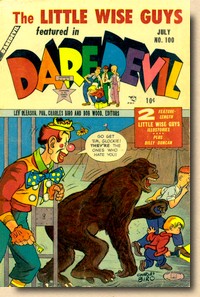 Daredevil
Comics #100 Daredevil
Comics #100
(Lev Gleason, July 1953)
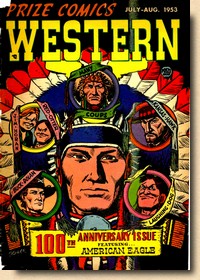 Prize
Comics Western #100 Prize
Comics Western #100
(Prize, July/August 1953)
|
|
| |
| Although the (televised)
hearings of
the United States Senate Subcommittee Investigating
Juvenile Delinquency dealing with comic books would only
take place in April 1954, Wertham's anti-comics crusade
had gathered enormous speed since 1950, and although the
Senate hearing was to focus only on horror and crime
comic books, publishers were scrambling to make sure they
would not wake up one morning and find themselves on the
wrong side of the line which Wertham was drawing. DC
Comics had a panel of educational and psychological
experts which were highly advertised on inside covers as
a reassurance to parents that the contents of DC's comic
books were checked and safe; other publishers had the
ACMP Star, and yet others, such as Archie, came up with
their own stamp of approval. |
| |
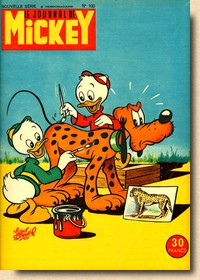 Journal
De Mickey #100 Journal
De Mickey #100
(Hachette, April 1954)
|
|
By the time 1954 rolled
around, many publishers outside the US also
started seeing centenary issues of their titles
(which in most cases reprinted US material). In
Australia, Feature's Adventurs of Brick
Bradford #100 hit the newsagents in January
1954 (featuring newspaper strips reprinted in
comic book format by King in the USA); in France,
Hachette's Journal de Mickey #100 came
out in April 1954 (featuring Disney material
reprints, this title is still being published
today, with the current issue count over the 3500
mark); and in Italy, Mondadori published Topolino
#100 (also a Disney material reprint title which
would run until 1988). None of these titles'
covers featured even the slightest celebratory
mention of the fact that they had reached their
100th issue.
Back in
the US, Gleason let another centenary pass by
silently in April 1954 with Boy Comics #100,
as did Archie Comics in August 1954 when they
published Suzie Comics #100. Silence, it
seems, was considered truly golden when it came
to centenaries - but then it was generally a
time, as pointed out, for comic book publishers
to try and fly under the radar.
This modus
operandi continued in 1955 with ACG's Teepee
Tim #100 (which today would probably be
spelled Tipi in order to avoid
embarrassing associations) which featured a very
bland cover with, no surprise, not even a hint as
to the title's special issue number.
|
|
| |
| ACG stuck to this procedure
when only two months later, when March/April 1955 saw the
publication of Spencer Spook #100 - although in
this case it was somewhat understandable, given the fact
that this comic book had for 99 issues carried the title
Giggle Comics. DC Comics published its next
centenary issue in April 1955 with Hopalong Cassidy
#100; acquired from the now defunct Fawcett Comics as of
issue #86, it too made no mention of the centenary, just
as Dell's Gene Autry Comics #100 in June 1955.
It had now been over two years that any publisher cared
to acknowledge, let alone celebrate the centenary of a
title - but things were about to change. At least a
little. |
| |
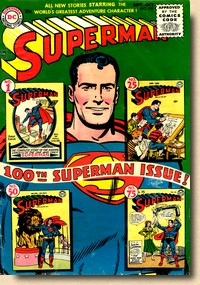
Superman #100
(DC, September 1955)
|
|
Detective Comics was
DC's flagship title, but the Man of Steel was
their real forerunner, and when Superman
#100 hit the newsagent stands in September 1955,
the long period of centenary silence was over as
the cover made it clear to potential buyers that
this was, indeed, the "100th SUPERMAN
ISSUE !". Sporting a Superman portrait
by Win Mortimer it also featured the covers of Superman
#1, 25, 50 and 75.
A nice
way to celebrate the title's centenary, the
contents of the issue, however, consisted of
three run-of-the-mill Superman stories which
could just as well have featured in the previous
or next issue. And as there was no editorial page
at all, the celebration remained restricted to
the cover of Superman #100.
The
same would be true for Batman #100, the
next big centenary for DC, in June 1956. Almost
an exact copy of the Superman centenary design,
it sported the same banner plus sa collage
featuring the covers of Batman #1, #23,
#25, #47, #48 and #61, but no special or
celebratory content at all.
|
|
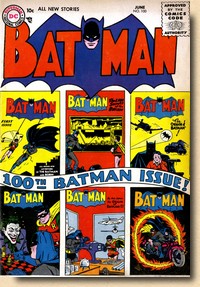 Batman
#100 Batman
#100
(DC, June 1956)
|
|
| |
| In between Superman
#100 and Batman #100, Dell had published Roy
Rogers and Trigger #100 (April 1956) and Quality
sent out Blackhawk #100 (May 1956) to the
newsstands, but both followed the established rule of
making no mention at all of the centenary - which was
also true for the first centenary issue of 1956, Harvey's
Dick Tracy #100. |
| |
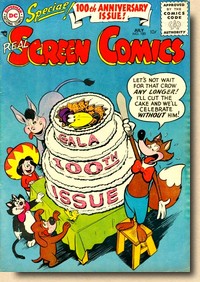
Real Screen Comics #100
(DC, July 1956)
|
|
It was again DC who changed
that tune a bit - by going back to the centenial
issue celebration roots with another birthday
cake cover, this time for Real Screen Comics #100
in July 1956.
But
while the cover celebrated the "GALA 100TH ISSUE", the
actual contents made no mention of the occasion
whatsoever - which wasn't for lack of page space
available for in-house use, as a full page ad for
DC's new Showcase title illustrated.
Rather, it was the same old routine of
"don't mention the centenary". It is
thus somewhat ironic that the ad for Showcase
pointed at something entirely new: Showcase
#4 (October 1956) would usher in the "Silver
Age" of comic books (1956-1970).
But
before that introduction of the new Flash and the
following revival of super-heroes, two more
Golden Age titles (both published by Dell)
reached the centenary issues count: Lone
Ranger #100 in October 1956 and Marge's
Little Lulu #100.
|
|
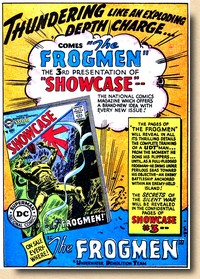
In-house ad from Real
Screen Comics #100 (DC, July 1956)
|
|
| |
| Neither of the two broke
with tradition, and hence didn't even mention the
occasion on the cover. During
the Golden Age of comic books, some 60+ titles reached an
issue number count of 100 between 1942 and 1956, but as
shown, only a mere handful pointed out the centenary to
readers with a blurb on the cover. Even fewer went as far
as to feature a special 100th issue cover (with birthday
cakes somewhat en vogue), and only one - Whiz
Comics #100 from August 1948 - actually featured a
special celebratory story.
Most publishers didn't even
blink, and while this all seems somewhat odd from the
marketing conscious perspective of the 1970s and onwards,
it was consistent with the way comic books were viewed at
the time both by the people who produced them and those
who read them. In the 1940s and 1950s comic books were
expendable reading with a collectible value to only a
very small group of fans. There was also very little to
no continuity at all between issues, other than the
central characters; it therefore didn't matter which
issue number a comic book carried. Editors also didn't
really bond with the readership, with the exception of
Fawcett in their Captain Marvel titles. The perception of
celebrating (and also cashing in on)
"anniversary" or "benchmark" issues
had yet to develop, even though Famous Funnies
#100 did hint at this in its editorial in October 1941.
The days of the
"long-awaited blockbuster spectacular collector's
item 100th issue" were yet to come, and they were
still quite far away in 1956.
|
| |
 |
| |
| BIBLIOGRAPHY MILLER John Jackson
(2011) "Where Did Comics Numbering Come From?
A look at why comic books are numbered unlike most
American magazines",
Comichchron.com, 10 July 2011
STALEY
Oliver (2018) "Stan Lee and Marvel saved the
comic-book industry after the US Congress tried to kill
it", Quartz
Online, 17 November 2018
WRIGHT
Bradford W. (2001) Comic Book Nation: The
Transformation of Youth Culture in America,
Johns Hopkins
|
| |
|
The illustrations presented here are
copyright material.
Their reproduction for the review and research purposes
of this website is considered fair use
as set out by the Copyright Act of 1976, 17
U.S.C. par. 107.

(c) 2020
uploaded to the web 9 February 2020
|
| |
 |




































